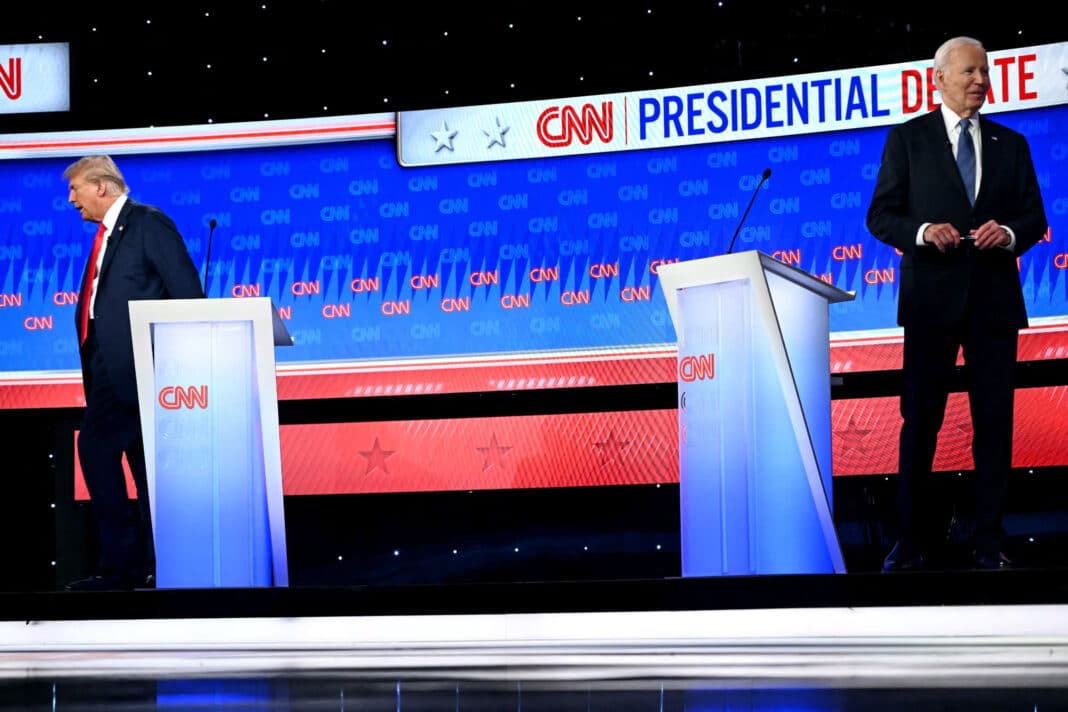In the highly anticipated debate between Biden and Trump, the nation was glued to their screens, witnessing what many expected to be a defining moment in the run-up to the presidential election. This debate held not just the potential to sway undecided voters but also to solidify the positions of those already loyal to either candidate.
Taking place amid escalating voter concerns, from age issues to policy stances, the presidential debate between Biden and former president Donald Trump was more than a mere political engagement—it was a litmus test for leadership in a time of profound national and global challenges.
First Impressions of the Debate
Biden’s initial performance was marked by noticeable struggles. From the onset, he appeared to falter, losing his train of thought and pausing awkwardly, prompting CNN moderators to intervene. His attempts to articulate plans for strengthening the U.S. health care system were notably disjointed, as he trailed off mid-sentence, leaving the statement incomplete.
This pattern persisted, with Biden often fumbling for words and appearing unsteady as he approached the podium. Despite a forceful start where he tried to challenge Trump’s handling of the COVID-19 pandemic, Biden’s delivery did not convey the decisiveness expected of a leader.
In contrast, Trump’s opening remarks were sharp and assertive. He quickly took advantage of Biden’s stumbles, using them to question Biden’s cognitive capabilities. Trump’s remarks on social media and during the debate highlighted his own past achievements, including acing cognitive tests and his recent golf course victories, to draw a stark comparison with Biden’s performance.
Trump’s rhetoric was forceful, especially on contentious issues like immigration, where he accused Biden of seeking open borders, framing it as a threat to national security.
The differing initial impressions set a tone for the debate, with Trump positioning himself as assertive and in command, while Biden’s performance raised concerns among viewers and Democratic insiders alike. House Democrats and former White House communications director Kate Bedingfield expressed disappointment, noting that Biden failed to demonstrate the vigor necessary to reassure the American electorate of his capabilities.
Critical Moments
Biden’s Stumbles
During the CNN presidential debate, President Joe Biden encountered significant difficulties that were evident to viewers and analysts alike. He frequently froze while speaking, most notably during a discussion on the economy, where he paused for several seconds, unable to continue.
This pattern of stumbling persisted throughout the debate, especially when discussing critical policies like job creation and healthcare costs, which are pivotal to his reelection campaign. These moments not only highlighted his challenges but also intensified concerns regarding his age and capability to lead, potentially jeopardizing the Democratic campaign.
Trump’s Dodges and Deflections
On the other side, former Trump utilized these stumbles by Biden to his advantage, often deflecting from substantive policy discussions. Despite his assertive demeanor, Trump’s responses were marred by inaccuracies and a focus on attacking Biden’s failures rather than articulating his own achievements or plans for a potential second term. His strategy included challenging Biden’s cognitive abilities and physical fitness for the presidency, which diverted attention from his own controversial statements and policy positions.
Policy Clash
Economic Policies
During the debate, Trump emphasized his administration’s economic achievements, particularly highlighting the tax cuts he implemented, which he claimed spurred “the greatest economy” the country had ever seen.
He criticized President Joe Biden for the current state of the economy, blaming his handling of the COVID crisis for sparking inflation. In response, Biden defended his economic policies, proposing higher taxes for corporations and the wealthy while promising to extend tax cuts for those earning less than $400,000 a year.
Immigration Stances
The debate also saw sharp contrasts in the candidates’ approaches to immigration. Trump reiterated his commitment to stringent border policies, including his promise to execute mass deportations and end birthright citizenship.
He accused Biden of causing harm by reversing his policies, which he claimed had kept the country safe. On the other hand, Biden highlighted his recent actions to manage border issues more humanely while ensuring security, such as his executive order to turn back migrants when crossings meet a certain threshold.
Healthcare and Abortion
A significant portion of the debate focused on healthcare and abortion, areas where the candidates have fundamentally different views. Biden criticized the Supreme Trump-appointed justices’ role in overturning Roe v. Wade and expressed his commitment to restoring the protections it offered.
He mentioned his efforts to reduce drug prices, including the Inflation Reduction Act, which caps insulin prices. Trump defended his record, claiming he had reduced insulin prices and arguing that returning the abortion issue to the states was a positive outcome. However, he faced criticism for his misleading statements regarding Democrats’ stance on abortion and healthcare.
These policy clashes not only highlighted the ideological divides between the candidates but also underscored the critical choices facing voters in the upcoming election.
Through the lens of the recent debate between Biden and Trump, it’s clear that both candidates presented contrasting stances that underpin the ideological divide permeating the current political landscape. Biden’s noticeable struggle with articulating his plans against Trump’s assertive and aggressive standpoint has stirred a myriad of reactions from the audience, political analysts, and the Democratic party. Concerns voiced by Democrats over Biden’s performance underscore the high stakes of this electoral battle, reflecting on the crucial need for strategic coherence and stamina in face of relentless opposition.
The contrasting policy positions, especially on matters of the economy, immigration, healthcare, and abortion rights, serve as a critical crossroads for American voters. The implications of this debate stretch beyond the immediate reactions, forming a foundational component of what will influence the electorate’s decision in the upcoming election. As the nation moves closer to casting their votes, this debate underscores the essential considerations voters are grappling with, between continuity and change, in determining the course of the nation’s future.




